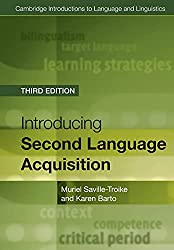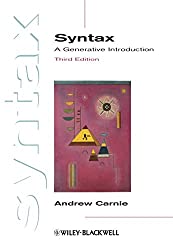
Rating: 7.0/10.
This is an introductory textbook on second language acquisition, approaching the subject from the perspective of linguistics, psychology, and sociology. Unfortunately, I didn’t enjoy this book and dropped it after about halfway through. It tries to cover a lot in only 200 pages, but the writing is disorganized, giving only a brief treatment of each topic before moving on. This enabled me to only become familiar with some of the terminology, but not enough detail to really appreciate the surprising results of each theory or the debates between competing theories. The material tended to be either painfully obvious, or incomprehensible.
Ch1: Introducing SLA
L2 refers to second language, whereas L1 is the native language. L2 can be learned in formal (eg: classroom) or informal settings, or a combination. Second language can be learned to live in another country, as an elective with no immediate application, or for specific (eg: academic) purposes.
Ch2: Foundations of SLA
Multilingualism is common in many parts of the world, Chinese is the language with most native speakers, while English has the most L2 speakers. However it’s difficult to gather information about number of speakers due to social, political, and linguistic reasons.
L1 learners acquire language in a fairly predictable order in all languages. For L2 acquisition, the initial state is the L1, and acquisition proceeds until the final state (also called fossilization). L2 learners benefit from already knowing how to construct sentences in L1 (positive transfer), but there are drawbacks from negative transfer.
SLA can be approached from several frameworks in linguistics (generative grammar, functionalism), psychology (neurolinguistics, connectionism), and sociology (variation theory, etc).
Ch3: Linguistics of SLA
Languages have many components that need to be learned, like lexicon, phonology, syntax, discourse, etc. Contrastive analysis looks at the grammar of two languages to predict which structures are likely to transfer positively or negatively. Error analysis collects samples of L2 and analyzes their errors, classifying them as intra-language (developmental) or inter-language (negative transfer). Interlanguage is the intermediate state of learner language from first exposure of L2 until fossilization.
Morpheme order studies examine the order that morphological constructions are acquired in L2, compared to the L1 order. The Principles and Parameters theory proposes that children have a Universal Grammar and learn language-specific parameters after hearing input.
Functionalism is looking at language as a method of communication instead of a system of rules. Both L1 and L2 speakers learn increasingly complex constructions to express different communicative situations. Klein and Purdue (1992) showed that speakers of any L1/L2 combination acquired morphology in a similar order: no verb, basic uninflected verb, then inflected verb.
Ch4: Psychology of SLA
Language functions are localized to different parts of the brain, and sometimes L1 and L2 can also be localized to different parts. Relation of L1 and L2 can be coordinate (parallel), compound (fused), or one language subordinate to the other.
The Information Processing model distinguishes between procedural and automatic processing. There is limited mental capacity for language processes, which has to be expended on lower level processes until they become automatic. Fluency is achieved from processes becoming automatic; timing studies can be used to measure automaticity.



